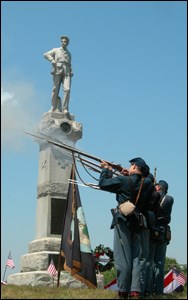
In order to protect Monocacy Junction, the B&O Railroad authorized the construction of two blockhouses - one south of the railroad tracks near the Georgetown Pike bridge, and one north of the railroad on the east side of the river. The blockhouses were constructed by soldiers from the 14th New Jersey Regiment. Corporal Nicholas Hagerman, of Company D, described the blockhouses in a letter dated April 13, 1863:
In 1862, the 14th New Jersey Regiment established a winter encampment at Monocacy Junction that they named Camp Hooker. The camp housed between 800 and 1,000 soldiers, and consisted of quarters for field and line officers, tents for enlisted men, ten cookhouses, two guard houses, a commissary, and a stable. Historical records also note that a hospital, a bakery, and a storehouse were at the camp. Soldiers from Camp Hooker also constructed earthworks on the high ground east and north of the railroad, including a gun battery, rifle pits, and a powder magazine. Soldiers from the 14th New Jersey Regiment returned to the Monocacy area to reinforce the bridges and other strategic targets during the Gettysburg Campaign in July 1863. The 14th New Jersey Regiment also participated in the Battle of Monocacy, suffering some of the heaviest Union casualties. Due to their intensive involvement with the Monocacy Junction area over the period of the Civil War, the 14th New Jersey eventually became known as "the Monocacy Regiment." A monument to the 14th New Jersey Regiment was erected in 1907 on the Best Farm overlooking Monocacy Junction.
|
Last updated: June 12, 2020
